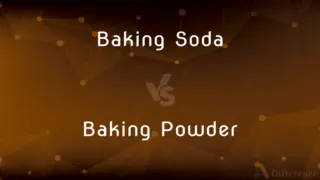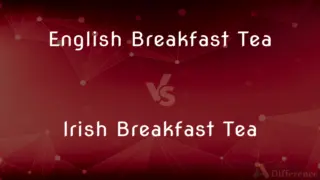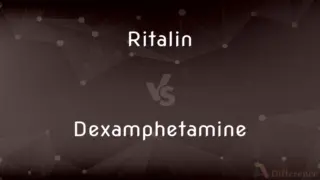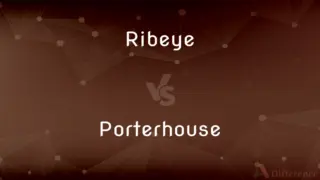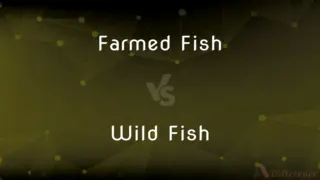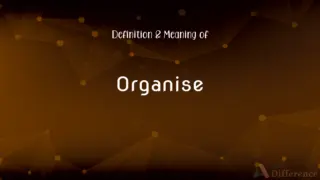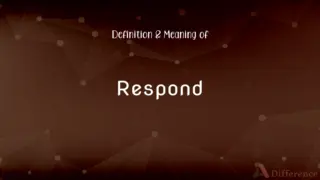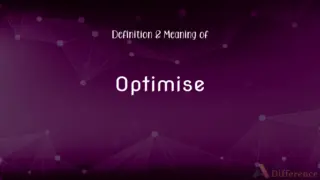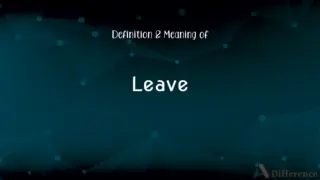Lowing vs. Mooing — What's the Difference?
Edited by Tayyaba Rehman — By Urooj Arif — Updated on April 6, 2024
Lowing is the deep, long sound made by cattle, typically when in distress or communication, while mooing is a more general, common sound made by cows for various reasons.

Difference Between Lowing and Mooing
Table of Contents
ADVERTISEMENT
Key Differences
Lowing refers to a specific type of vocalization by cattle, often deeper and more prolonged, associated with a range of emotions from distress to communication with their offspring or other herd members. On the other hand, mooing is the broad term used for the typical sound cows make, which can vary in pitch and length and is used in various contexts, such as signaling hunger, socializing, or expressing discomfort.
The term "lowing" often conveys a sense of solemnity or concern, reflecting the emotional state of the animal, such as calling for a calf or expressing unease. Mooing, conversely, is a more general and versatile sound that can indicate anything from curiosity to contentment, making it a common part of the auditory landscape of a farm.
Lowing is usually more resonant and can be heard over longer distances, making it an effective means for cattle to communicate with each other across the expanses of fields or pastures. Whereas mooing can be softer or louder depending on the situation and is not necessarily intended for long-distance communication but can serve as a means of expressing immediate needs or reactions.
In literature and culture, lowing is often depicted in more poetic or dramatic contexts, highlighting its association with the natural world and the emotional lives of animals. Mooing, while also present in cultural depictions, is often portrayed in a more everyday or humorous context, reflecting its commonality and the variety of situations in which cows vocalize.
While both sounds are integral to cattle behavior and communication, the distinction lies in the context and emotional content of the vocalization. Lowing, with its deeper, more sustained tone, often signals more significant communication or emotional expression, whereas mooing serves as a versatile and everyday form of vocalization for cows.
ADVERTISEMENT
Comparison Chart
Definition
A deep, long sound made by cattle
A general sound made by cows
Associated Emotions
Distress, communication
Hunger, socializing, discomfort
Communication Range
Longer distances
Immediate surroundings
Cultural Depiction
Poetic, dramatic
Everyday, humorous
Function
Significant communication, emotional expression
Versatile, everyday vocalization
Compare with Definitions
Lowing
A deep, prolonged sound made by cattle.
The farmer heard the lowing of a distressed cow in the field.
Mooing
A common sound made by cows.
The barnyard was filled with the sound of mooing at feeding time.
Lowing
A form of communication among cattle.
The lowing across the pasture facilitated herd coordination.
Mooing
A means of expressing immediate needs.
The persistent mooing indicated the cows' hunger.
Lowing
A resonant call over distances.
The lowing served as a beacon for the scattered herd at feeding time.
Mooing
An everyday occurrence on farms.
Morning in the countryside began with the mooing of the dairy cows.
Lowing
Vocalization expressing concern or distress.
The cow's lowing at dusk was a call to her lost calf.
Mooing
Vocalization for various purposes.
The cow's mooing signaled it was time to be milked.
Lowing
A sound indicating a change in emotional state.
The noticeable lowing suggested the cow sensed danger.
Mooing
A social sound among cattle.
The playful mooing among the calves strengthened their social bonds.
Lowing
The calling sound made by cows and other bovine animals.
Mooing
To emit the deep, bellowing sound made by a cow; low.
Lowing
Lowing is a Scottish surname, and may refer to:
Mooing
The lowing of a cow or a similar sound.
Lowing
The characteristic sound uttered by cattle; a moo.
Mooing
Present participle of moo
Lowing
To utter the sound made by cattle; moo.
Mooing
The action of the verb moo; a mooing sound.
Lowing
Present participle of low
The cattle are lowing, the baby awakes.
Mooing
(of a steak) very rare
Lowing
The sound of something that lows.
Common Curiosities
Can humans distinguish between lowing and mooing?
Yes, humans can typically distinguish between the deeper, more sustained lowing and the more varied sounds of mooing based on context and tone.
How do lowing and mooing differ in purpose?
Lowing often serves specific, significant communication needs or emotional expressions, whereas mooing covers a range of everyday situations and needs.
Are lowing and mooing used interchangeably?
While related, they are not used interchangeably; lowing refers to a specific type of vocalization, while mooing is a general term for cow sounds.
What is lowing?
Lowing is a deep, prolonged sound made by cattle, often indicating distress or communication.
What is mooing?
Mooing is the characteristic sound made by cows, used for various forms of communication and expression.
Why do cows moo?
Cows moo for various reasons, including signaling hunger, socializing, expressing discomfort, or responding to environmental changes.
Do all cattle low and moo?
Yes, all cattle are capable of both lowing and mooing, though the reasons and contexts for each sound may vary.
Is lowing a sign of distress?
Lowing can be a sign of distress, but it is also used for other forms of deep, emotional communication.
How do farmers interpret cow vocalizations?
Farmers interpret cow vocalizations based on their knowledge of individual animals and context, discerning needs or behaviors accordingly.
Are there cultural or literary references to lowing and mooing?
Yes, both lowing and mooing appear in cultural and literary contexts, with lowing often depicted more dramatically or poetically, and mooing in more everyday or humorous situations.
What emotions do cows express through lowing?
Cows can express distress, concern, or a desire to communicate with their offspring or other herd members through lowing.
Does mooing vary between individual cows?
Yes, mooing can vary in pitch, duration, and intensity between individual cows, reflecting their personality or immediate context.
How important is mooing in a cow's communication?
Mooing is crucial for a cow's everyday communication, signaling everything from social interaction to basic needs.
Can lowing be heard over long distances?
Yes, lowing is resonant and designed to carry over longer distances than ordinary mooing.
What role does lowing play in herd dynamics?
Lowing plays a significant role in herd dynamics by facilitating communication across distances, essential for coordination and cohesion.
Share Your Discovery

Previous Comparison
Covert vs. Clandestine
Next Comparison
Swap vs. SweepAuthor Spotlight
Written by
Urooj ArifUrooj is a skilled content writer at Ask Difference, known for her exceptional ability to simplify complex topics into engaging and informative content. With a passion for research and a flair for clear, concise writing, she consistently delivers articles that resonate with our diverse audience.
Edited by
Tayyaba RehmanTayyaba Rehman is a distinguished writer, currently serving as a primary contributor to askdifference.com. As a researcher in semantics and etymology, Tayyaba's passion for the complexity of languages and their distinctions has found a perfect home on the platform. Tayyaba delves into the intricacies of language, distinguishing between commonly confused words and phrases, thereby providing clarity for readers worldwide.




